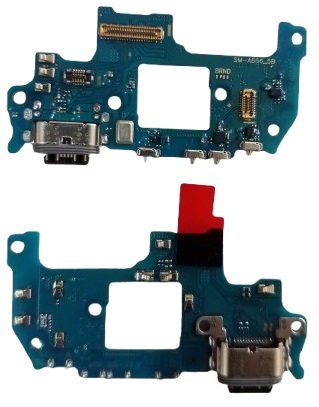
The Samsung A55 charging board is a crucial component of the Samsung Galaxy A55 smartphone. It’s an integral part of the phone’s hardware responsible for managing the charging process and power distribution to the device. Below is a detailed explanation of the charging board, its functionality, structure, and related aspects.
1. Purpose of the Charging Board
The charging board’s main job is to ensure the proper transfer of power from the charging port to the battery of the smartphone. It’s designed to manage various aspects of charging, such as voltage regulation, current flow, data transmission (like USB data transfer), and communication between the device and the power supply.
2. Key Functions of the Charging Board
- Power Input Management: When you plug in a charger (either via USB Type-C, Micro-USB, or another connection type), the charging board handles the incoming power. It ensures that the power is at the correct voltage and current required by the battery.
- Voltage Regulation: Depending on the charger and the battery’s needs, the charging board regulates the incoming voltage. If the charger is supplying more voltage than the battery can handle, the board steps it down to prevent overcharging or damage to the battery.
- Current Control: The charging board ensures that the correct amount of current is supplied. For instance, fast charging involves higher current, but the board regulates this to prevent overheating and to protect the battery life.
- Power Distribution: The charging board also controls the distribution of power across different components of the device. For example, it ensures that not only the battery gets power but also powers essential components like the motherboard and display.
- Data Transfer: Most charging boards also support data transfer through the same port used for charging. This enables syncing, transferring files, or connecting to a computer while the device is charging.
3. Design and Components of the Charging Board
- USB Port (or Charging Port): The charging port, such as a USB-C or Micro-USB connector, is a part of the charging board. This is where the charger cable connects.
- Integrated Circuits (ICs): The charging board contains several specialized integrated circuits that control voltage regulation, power management, and sometimes fast charging technology (like Qualcomm Quick Charge or USB Power Delivery).
- Fuses and Protection Circuits: Charging boards often include protection components, such as fuses and resistors, to protect against overcharging, overheating, and short circuits.
- Power IC (Integrated Circuit): This component handles the actual regulation of voltage and current to ensure the phone’s battery is safely charged. It also communicates with the battery to monitor its charge level.
- Inductors and Capacitors: These components are used for filtering and stabilizing the power supply, ensuring a consistent and smooth charging experience.
4. Fast Charging Technology
Many modern smartphones, including the Samsung A55, support fast charging technology. The charging board plays a key role in implementing this technology by:
- Higher Voltage and Current Handling: Fast charging requires the board to manage higher current (in some cases, up to 25W or more) to rapidly charge the battery.
- Smart Power Management: The charging board adjusts the power flow to match the battery’s charging curve, ensuring efficiency and safety.
- Communication Protocols: The charging board uses communication protocols like USB-PD (Power Delivery), Qualcomm Quick Charge, or other proprietary solutions to negotiate optimal charging conditions with the charger.
5. Battery Protection and Safety Features
The charging board integrates multiple safety features to protect both the phone and the user:
- Overcharge Protection: The board ensures that once the battery reaches 100% charge, charging stops automatically, preventing battery damage.
- Thermal Protection: If the board detects high temperatures during charging, it will slow down or halt the charging process to prevent overheating.
- Short-Circuit Protection: If there is a fault in the charging circuit, the board can detect the short and will cut off the power supply to prevent damage to both the device and charger.
- Overvoltage Protection: The board prevents any harmful excess voltage from reaching the battery, which could lead to battery degradation or even hazardous situations.
6. Replacement and Repair Considerations
If the charging board becomes faulty or damaged, it can lead to charging issues such as:
- No Charging: The phone may not charge at all, even when the charger is connected.
- Slow Charging: If the charging board is damaged, it may not properly manage the power flow, resulting in slow or intermittent charging.
- Overheating: A malfunctioning charging board can cause excessive heat, damaging the battery or other internal components.
In such cases, the charging board typically needs to be replaced. This process is often complex and should be carried out by a professional technician, as it involves soldering and working with delicate internal components.
7. Related Components
- Battery: The charging board interacts closely with the battery. While the board ensures that the battery receives the correct power, the battery’s health and capacity are also key factors in how well it charges.
- Motherboard: The motherboard communicates with the charging board to monitor charging status and battery health.
- Charging Cable and Adapter: The efficiency of charging can also depend on the charging cable and adapter, as they must match the specifications supported by the charging board.
Conclusion
In the Samsung Galaxy A55 or any smartphone, the charging board is a sophisticated piece of technology that ensures the safe, efficient, and rapid charging of the device. It regulates the power flow from the charger to the battery, incorporates safety features, supports fast charging technologies, and may also manage data transfer. Understanding its role and importance is crucial for maintaining optimal phone performance and battery health.